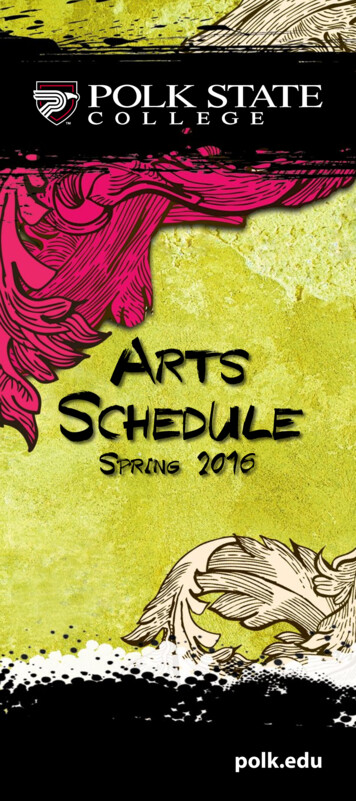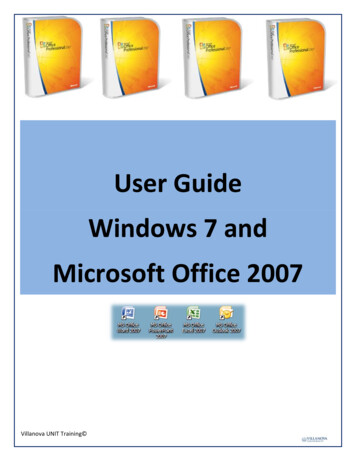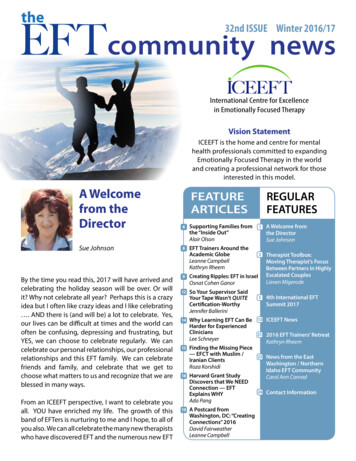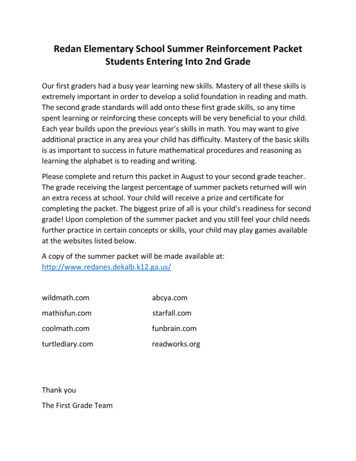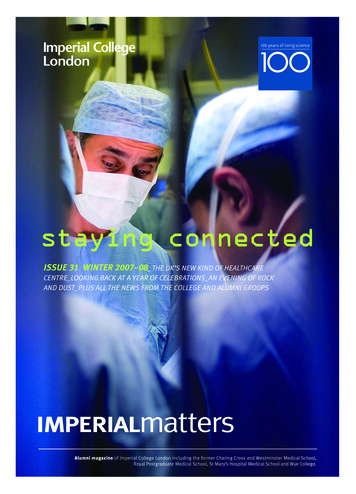
Transcription
Imperial Matters 31 QX6/2/0808:26Page 37headISSUE 31 WINTER 2007–08 THE UK’S NEW KIND OF HEALTHCARECENTRE LOOKING BACK AT A YEAR OF CELEBRATIONS AN EVENING OF ROCKAND DUST PLUS ALL THE NEWS FROM THE COLLEGE AND ALUMNI GROUPSIMPERIALmattersAlumni magazine of Imperial College London including the former Charing Cross and Westminster Medical School,Royal Postgraduate Medical School, St Mary’s Hospital Medical School and Wye College.
ISSUE 31 WINTER 2007–08in this issue .1215161718REGULAR FEATURES26ALUMNI NEWS1editorial by Sir Richard Sykes22 networks and groups2letters26 Imperial’s international ambassadors28 alumni focusNEWS30 media mentions3Imperial news314faculty news32 in memoriambooks33 honoursFEATURES12wrapping up our Centenary year looking back at a year of celebrations15Centenary celebrations reunite alumni at the Alumni Reunion 200716dust rocks! alumnus and Queen guitarist Brian May explains zodiacal dust17a rare vintage the possibilities of Manchester Merlot and Sheffield Shiraz18 a giant step for UK healthcare a look at the UK’s first Academic Health Science Centre20 Africa: health matters? leading academics gather to discuss African healthcare21good advice shaping the College’s future success in fundraisingEXCLUSIVE ONLINE FEATURESnew Department of Life Sciences to encourage collaboration across the spectrum of life scienceshappy 10th birthday medicine celebrating 10 years since the Faculty’s formationschistosomiasis control initiative awarded the Queen’s Anniversary Prizecelebrating strong links with Asia at the Asia ConvocationIMPERIALmattersPRODUCED BY THE OFFICE OF ALUMNI AND DEVELOPMENT AND IMPERIAL COLLEGE COMMUNICATIONSEDITOR ZOË PERKINSMANAGING EDITOR SASKIA DANIELEDITORIAL CONTRIBUTORS LIZ GREGSON, ABIGAIL SMITH, LAURA GALLAGHER, DANIELLE REEVES, COLIN SMITHAND NAOMI WESTONDESIGN JEFF EDENPRINT PROLITHO LTDDISTRIBUTION PHAROS INTERNATIONALIMPERIAL MATTERS IS PUBLISHED TWICE A YEAR. THE NEXT ISSUE WILL BE PUBLISHED IN JULY 2008AND THE COPY DEADLINE IS FRIDAY 16 MAY 2008.ADDRESS FOR MAGAZINE ENQUIRIES:ZOË PERKINS, OFFICE OF ALUMNI AND DEVELOPMENT, IMPERIAL COLLEGE LONDONSOUTH KENSINGTON CAMPUS, LONDON SW7 2AZz.perkins@imperial.ac.uk IMPERIAL COLLEGE LONDON, 2008. ALL RIGHTS RESERVED.27
Imperial Matters 31 QX6/2/0808:26Page 1RALPH HODGSON, JAN CHLEBIKeditorialDEAR ALUMNUS,It gives me great pleasure to say hello through the pages of thiswinter 2007–08 edition of Imperial Matters, and I thank you foryour continued interest in Imperial College.You may be aware that Imperial has just completed a momentousyear, encompassing not just our Centenary but also independence asa university in our own right, a royal visit by Her Majesty The Queenand Gordon Brown’s first outing to a UK university as Prime Minister.The year also saw Imperial named the fifth best university in theworld in the Times Higher Education Supplement World UniversityRankings, a great tribute to the dedication of the College’s staff.Perhaps the achievement that will have the most far-reachingimpact on people’s lives here in the UK, however, is our creationof an Academic Health Science Centre. On 1 October 2007, withthe newly-merged St Mary’s and Hammersmith Hospitals Trusts,the College formed Imperial College Healthcare NHS Trust.This integration of teaching and research with the delivery ofpatient care, a first for the UK, will create a healthcare centre ofinternational standing, in which breakthroughs move speedilyfrom bench to bedside. You can read more about this excitingprospect on page 18.The past year has been enriched by many alumni events,including the Centenary Reunion in September, which saw around900 people return to the College to see what has changed andwhat has stayed the same. I imagine that some of you readingthis attended the event, and I hope that it brought back somehappy memories – we are always thrilled to have you back, andwe look forward to many more opportunities to get together inthe future. Turn to page 12 to read about many of the celebratoryevents that took place during 2007, and read more about thereunion on page 15.This year also saw the return of one particularly well-knownImperial student, who finally completed the PhD he started over30 years ago and which he abandoned in favour of a blossomingmusical career with Queen. You can read about Dr Brian Mayon page 16.Of course, Imperial’s alumni family is a global one, and incelebration of that we held the College’s first graduation ceremonyoutside the UK during my time as Rector. Our Asia Convocation,held in the magnificent surroundings of Singapore’s UniversityCultural Centre, offered a wonderful opportunity to visit the regionfrom which so many of our students hail, and was part of a widertrip to Asia that encompassed several events and meetings withmembers of alumni associations in Singapore, Malaysia, Thailandand India. My thanks go to them all for their great hospitality.My message at the Asia Convocation ceremony, as it is at allof our graduation ceremonies, was that graduation day does notrepresent the end of your relationship with Imperial. We see it asan ongoing connection and hope that you do too.So, my thanks go to all who attend alumni events through theyear, who read this magazine and contact us with their views, andwho share their memories of Imperial and let us know about theirpost-Imperial accomplishments.Our Centenary Campaign to raise 207 million throughphilanthropic support is well underway, and I would like toexpress my thanks to all of our generous supporters, many ofwhom have given through the Annual Fund. You will find issuenine of building the connection enclosed with this mailing, whichcontains news of recent gifts to the campaign.Imperial is embarking on its second century with a great senseof optimism and we are delighted that you wish to join us on thenext stage of our exciting journey.IMPERIAL MATTERS WINTER 2007–08 1
Imperial Matters 31 QX6/2/0808:26Page 2letterslettersOperation DebrettOn Coronation Day, 2 June 1953, I took part in ‘Operation Debrett’ toprovide refreshments for the distinguished guests in WestminsterAbbey. I wrote an account of my experiences that night as I wasmuch too excited to sleep.Our duties were to feed guests from the Parliament Square standsbetween 7am and 12pm; and then to feed Westminster Abbey guestsfrom 2pm onwards. There was an important difference between thesetwo services; before 2pm everything was sold, and afterwards the costwas charged to Her Majesty.There were 20 Imperial College students; some coats wereproduced for the kitchen porters, they were mostly blue but therewere also three white ones. I was fortunate and was selected towear a white coat, and given the task of taking round trays of cakesand sandwiches.Just before the Queen was due to arrive in Parliament Square, wecleared to watch her. I arrived three minutes early inside the gates ofthe Houses of Parliament and was told to climb down. But I stood ontip-toe and saw the Queen’s face and hand through her coach window.As the service commenced, we had our lunch of ham and beef,lettuce, tomatoes, sausage rolls and a cake. Afterwards there wasa great rush to get everything ready for the Abbey guests.When the first guests came from the Abbey, the kitchen porterswere hurriedly ordered into the washing up room at the end of thecounter and gazed out amazed on princes, bishops and knights.I recognised the Dean of Westminster, the Bishop of Durham,the Moderator of the Church of Scotland, the Pope’s representativeand various Knights of the Garter.PROFESSOR DENNIS MABEY (Aeronautics 1952, MSc 1953, VisitingProfessor 1991–1998)Dennis Mabey’s full account of Operation Debrett can be foundonline at www.imperial.ac.uk/alumni/mabey.D-Day examsHaving attended the Centenary reunion celebrations, which Ithoroughly enjoyed, I thought that you might be interested in myrecollections of my final year at Imperial in 1944.My most vivid memory is of the final exams, which started on 6 June1944 in the old drawing office. Not content with it being D-Day and allthe excitement of that, it was also the start of the doodle bugs. Duringthis first exam, the air raid sirens went and when one of themapproached the College the internal alarm from the spotter on the roofsounded and we had to take shelter under the heavy drawing desks.This happened no less than three times and, by the second and thirdwe realised that the invigilator’s desk was closed in the front facing usand therefore he could not see what we were up to. What a chance towhisper about the questions! This type of interruption did not occurduring any of the other exams and I suppose that the doodle bugswere being aimed at other targets.JOHN WAITERS (Civil and Environmental Engineering 1944)2 IMPERIAL MATTERS WINTER 2007–08Fond memoriesMy student apprenticeship with D. Napier and Sonfrom 1946 to 1949 included study of gas turbinetechnology and heat transfer at Imperial College,and I still have the textbook on heat transfer thatwas subsequently published by M. Fishenden andO.A. Saunders. It is pleasant to recall the lecturesthey gave. She was always called “Ma” Fishenden by the students,perhaps because she was slightly older than Saunders. Herinformation on the theoretical side of heat transfer was alwaysaccompanied by his experimental data that confirmed the theory.ALAN MACDONALD (Mechanical Engineering 1948)Redressing the balanceI was interested to read about Imperial’s new status as a fully fledgeduniversity and the Rector’s comments about how it was fitting thatSouth Kensington was the locus for a university due to theconglomeration of academic bodies. It was an idea identified over30 years ago when Trevor Phillips and I founded a newsletter entitledthe University of South Kensington Entertainments Sheet, or USKENTSfor short. I think it ran for quite a few years after we left in 1971.The newsletter came about because engineering-based Imperialwas always short of female ‘talent’ at the various entertainmentfunctions and it was thought that by advertising the various events inother local colleges, particularly the teacher training ones that had ahigh female/male ratio, the balance could be redressed.It must have worked to some extent as two of my colleaguesmarried teachers! We didn’t have the medical schools at that time, butI remember printing several hundred copies for distribution to theFrench Lycee, Maria Assumpta College, the College of EstateManagement, Chelsea College and the Royal College of Art. The primefocus was obviously on Imperial College events, but we tried toinclude other College’s events to try and get Imperial students totheirs, as well as their students to ours.TIM SMITH (Aeronautics 1971)Please send your letters to: Imperial Matters, Office of Alumni andDevelopment, Imperial College London, South Kensington Campus,London SW7 2AZ or by email to matters@imperial.ac.uk.We reserve the right to edit for length. Letters will also appear onthe Imperial College website as part of the online edition ofImperial Matters. Please note that any views expressed here arethose of the contributors and do not necessarily reflect those ofImperial College London.
Imperial Matters 31 QX6/2/0808:26Page 3Imperial news CollegeNEVILLE MILESImperial’s two Commemoration Dayceremonies, held in October, celebratedthe graduation of over 2,000undergraduates. These were the firstgraduation ceremonies the Collegecelebrated as an independentinstitution, following its withdrawal fromthe University of London in July 2007.In addition, honorary Imperialdoctorates were awarded to LordBrowne, former Group Chief ExecutiveOfficer of BP; Dr Lisbet Rausing, Senior Research Fellow in theCollege’s Centre for the History of Science, Technology and Medicine;and Dr Craig Venter, leading scientist in the field of genomic research.Addressing the new honorary graduands, Sir Richard Sykes, Rectorof Imperial College, said: “Lord Browne is a real cheerleader for thegood that science can do, having made huge efforts to position BP asa leader in developing greener and more sustainable energy during histime as Chief Executive.”He added: “Craig Venter and Lisbet Rausing have both made hugeefforts to advance science; Dr Venter as a scientist of greatimagination, and Dr Rausing as both a researcher here at Imperial andas a generous philanthropist.”Reaching outFrom robotics to biology and from chemistry to art, Imperial’s OutreachOffice inspired over 3,500 young people in 2007. Aimed at raisingaspirations amongst school pupils and igniting their interest in theworld of science, theOutreach Office hasorganised over 70different science eventsincluding workshops onalternative energy, thescience of crime sceneinvestigations and therelationship betweenchemistry and art.The Creative Futuresevent held in October 2007 was organised by the College’s race equalitygroup, Imperial As One, and focused on interactive workshopsintroducing the pupils to hands-on science. The neuroscienceworkshop asked the pupils, does colour influence flavouridentification? Using four different flavoured soda drinks and oneunflavoured, clear drink, the pupils had to record how the colourinfluenced their sense of taste and how mixing the substances made itharder to identify the flavours.Melanie Thody, Head of Outreach at the College, emphasises theimportance of these activities. She said: “Our programme here atImperial is designed to give pupils a taste of life at university andprovide them with the opportunity of working with academics anduniversity students.”Southside opens,Eastside demolishedOver 400 first yearstudents moved into thenew Southside halls ofresidence that openedtheir doors at the end ofSeptember 2007.Southside accommodatesstudents in single andtwin en suite studybedrooms and providesa medical and dentalcentre, and a student social space, for the residents.The new halls, pictured, have been built to replace the oldSouthside building, which was originally constructed in 1963 andknocked down in the summer of 2005. The new building has takenover two years to build and still comprises the three original halls:Tizard, Selkirk and Falmouth Keogh.Following on from the success of Southside, work to demolish asecond hall of residence, Linstead Hall and its extension (known asEastside), is now underway. This is a continuation of the Prince’sGardens restoration project, which aims to provide accommodation foras many undergraduates as possible within a 15-minute walk of SouthKensington Campus’ academic facilities, as well as improved amenitiesfor students, local residents and visitors.The new accommodation will be split into three separate hallsrather than one, and will house 430 students. The work is due to becompleted by September 2009.NEVILLE MILESCommemoration Daycelebrates student success NEWS IN BRIEF NEWS IN BRIEF NEWS IN BRIEF NEWS IN BRIEF NEWS IN BRIEF NEWS IN BRIEF NEWS IN BRIEF NEWS IN BRIEF NEWS IN BRIEF Fifth best university in theworld Imperial has been named thefifth best university in the world, aleap of four places from last year, inThe Times Higher EducationSupplement’s 2007 World UniversityRankings, which comprise peerassessment, graduate recruiterfeedback, research citations andstudent-staff ratios. CongratulatingImperial’s staff, Sir Richard Sykessaid: “Today’s recognition reflects thecommitment and brilliance that youdemonstrate every day – it is thatwhich makes the College a worldleading institution.”Malawi bridge success Fivestudents from Imperial College havebuilt a bridge in Malawi, helping localpeople cross the river to collectfirewood and patrol against poachers.The 37-metre suspended footbridgewas constructed across the NorthRukuru River at Uledi on the northwestern corner of Nyika NationalPark. During the wet season the riverpreviously split Uledi in two, cuttingoff half of the village. Thirty peoplefrom the local community also gotinvolved with the building project.RISE Realise equality, celebrateSet for success Two Imperialdiversity was the theme for studentRISE week, the Union’s racialawareness campaign, held inNovember 2007, which aimed toencourage integration and toleranceof others on all the College campuses.Students had the opportunity to tryout a different international dish andsee international films screened atthe Union. The week coincides withStudent RISE month organised bythe Mayor of London to promote thediversity of London’s students andtheir opposition to racism.undergraduates won awards at theScience, Engineering and TechnologyStudent of the Year Awards inSeptember 2007. Richard Hayden,from Imperial’s joint mathematics andcomputing degree course, won theMicrosoft Research Award for theBest Computational Science Student,which is judged by the BritishComputer Society. Stephen Motley,from the Department of Electrical andElectronic Engineering, won the e2vTechnologies Award for the BestElectronic Engineering Student.IMPERIAL MATTERS WINTER 2007–08 3
Imperial Matters 31 QX6/2/0808:26Page 4Imperial news EngineeringPrime Minister viewsinnovative health technologyIAN GILLETTThe benefits of applying technologicalknow-how to patient care weredemonstrated to the Prime Minister,Gordon Brown, at Imperial College inOctober 2007. Sir Richard Sykes andLord Ara Darzi, Professor of Surgeryand Department of HealthParliamentary Under Secretary, tookthe Prime Minister on a tour of theCollege’s newly launched Institute ofBiomedical Engineering.The Prime Minister took a special interest in the virtual operatingtheatre used for cardiac microsurgery. The College’s Director ofMedical Imaging, Professor Guang-Zhong Yang, discussed theapplications of robotic surgical devices whilst Lord Darzi carried out avirtual medical procedure in front of Mr Brown.This was the first visit by Mr Brown to a UK university since becomingPrime Minister. It followed the launch of the Imperial College HealthcareNHS Trust, the UK’s first Academic Health Science Centre, formedthrough the merger of Hammersmith Hospitals NHS Trust, St Mary’s NHSTrust and Imperial College. You can read more about this on page 18.A new vision is outlined forengineering educationThe Minister of State for Science andInnovation, Ian Pearson, along withleaders in industry and academiagathered for the Global Sustainability:the future for engineering educationforum to discuss the direction of UKundergraduate engineering.In partnership with Arup, BP,Engineers Against Poverty, the Instituteof Education and Schlumberger,Imperial held the high-level strategyforum to set the agenda for changesthat will embed sustainability inengineering education.The forum formed part of Imperial’s EnVision 2010 project – a majorinitiative by the Faculty of Engineering to promote excellence inteaching, learning and academic leadership.Keynote speaker Jonathan Porritt, Chairman of the UK SustainableDevelopment Commission, said there was a need for new mindsets,technologies, responsibilities and business models and that highereducation needed to be at the forefront of this change. He praisedImperial’s EnVision 2010 initiative as a great step in the right direction.Read more on page 11 of building the connection.Search for life inMartian ice relies onUK technologyDr Tom Pike and histeam from theDepartment ofElectrical andElectronicEngineeringwitnessed the USlaunch of the NASAMars PhoenixMission in August2007. The team hadmicro-machinedsubstrates that willhold dust and soil for examination in a microscope station attached tothe Phoenix lander.When the Mars lander touches down in May 2008, Dr Pike and histeam will join international experts at mission control in Phoenix,Arizona, to begin their search for conditions favourable for past orpresent life. Dr Pike and his team will dig and analyse soil excavatedfrom the Vastitas Borealis region.“Nobody has looked at Mars at this type of resolution. It is verydifficult to predict what we might find, but if you wanted to look forthe earliest forms of past or present life we will be the first to lookclosely enough,” said Dr Pike.“This is the first chance since the Beagle mission that the UK willbe able to help explore the surface of Mars. It is great to have theresources and the people at Imperial to enable us to take part in thismission,” he added. NEWS IN BRIEF NEWS IN BRIEF NEWS IN BRIEF NEWS IN BRIEF NEWS IN BRIEF NEWS IN BRIEF NEWS IN BRIEF NEWS IN BRIEF NEWS IN BRIEF The Engineer honours lifetime ofachievement Emeritus ProfessorColin Caro, Department ofBioengineering, was celebrated at TheEngineer magazine’s inauguralTechnology and Innovation Awards inSeptember 2007. He was given aspecial award for outstanding personalachievement, voted for by engineeringprofessionals, in recognition of hiswork on physiological and medicalresearch. “It gives me enormouspleasure to be honoured by engineers.I started life as a medic and it is ‘fun’to be recognised for my work inengineering,” he said.4 IMPERIAL MATTERS WINTER 2007–08New Head of BioengineeringProfessor Ross Ethier, previouslyDirector of the Institute of Biomaterialsand Biomedical Engineering at theUniversity of Toronto, joined Imperialas the new Head of the Department ofBioengineering in August 2007.Professor Ethier is a Fellow of both theAmerican Society of MechanicalEngineers and the American Instituteof Biology and Medicine inEngineering. “Bioengineering is awide open field with huge potential.I look forward to working with myteam, and further developing a greatdepartment,” he said.First female scientist to win topaward Dr Molly Stevens,Blue dye could hold the keyto super processing powerDepartment of Materials, was the firstfemale scientist ever to be awardedthe prestigious Royal PharmaceuticalSociety of Great Britain’s ConferenceScience Medal in August 2007. DrStevens received the honour for herindependent research innanomaterials for bio sensing ofdisease related proteins, and in selfassembling nanomaterials to helpbones and cartilage quickly repair.She said: “I think it is an importantmilestone for women in the field.”Dr Sandrine Heutz, Department ofMaterials, has developed a techniquefor controlling the magnetic propertiesof a commonly used blue dye knownas metal phthalocyanine (MPc). Herexperiments with MPc have thepotential to revolutionise computerprocessing power. The teamexperimented with crystals containingMPc in different conditions and wereable to exploit their magnetic qualitiesto reorder the molecules, which theybelieve could be used for informationprocessing at the nanoscale.
Imperial Matters 31 QX6/2/0808:26Page 5Imperial news EngineeringChemical imaging: potentialnew crime busting toolA team, led by Professor Sergei Kazarian from theDepartment of Chemical Engineering and ChemicalTechnology, has devised a technique whichcollects fingerprints along with their chemicalresidue and keeps them intact for future reference.This new technique has the potential to detect thediet, ethnicity and sex of a suspected criminal.They found that gel tapes, spectroscopicimaging and the use of an array detector,originally developed by the United States military for smart missiletechnology, give a detailed chemical composition, or chemical‘photograph’, of a fingerprint.The process could potentially identify traces of items people havecome in contact with, such as gunpowder, narcotics, and biologicalor chemical weapons.Chemical clues could also highlight specific traits in a person.A strong trace of urea, a chemical found in urine, could indicatea male. Weak traces of urea in a chemical sample could indicate afemale. Specific amino acids could potentially indicate whetherthe suspect was a vegetarian or meat-eater.Professor Kazarian believes that this technique could allow forensicscientists to observe how fingerprints change in time and withindifferent environments.Speculating about the possible future benefits, Professor Kazariansaid: “In the courtroom of the near future, chemical images could featureas key evidence. I hope our work brings dangerous criminals to justice.”Centre for PervasiveSensing launchedThe Centre for Pervasive Sensing was launched in July 2007 bringingtogether researchers within the College to integrate, identify and developtechnologies in pervasive sensing. One of its first acts was to distribute 80,000 to seven Imperial-based projects making advances in wirelesssensor networks – from healthcare to environmental engineering.A range of projects received funds including work on pervasivesensing in total knee replacement, environmental monitoring ofbuilding structures, electrochemical sensors for measuring waterquality and flow velocity, remote monitoring of spreading braindepolarisation, and cost effective traffic and road condition monitoring.Professor Guang-Zhong Yang, Chair of the Centre for PervasiveSensing, said it was important that the College could now focus onfurther developing this research: “Imperial has an established recordin pervasive sensing research and I am pleased that we now have thecapability to coordinate and distribute funding to projects College-wide.”Sporting glory is allin the earProfessor Guang-Zhong Yang,Director of Medical Imagingand Robotics Research at theInstitute of BiomedicalEngineering, and his teamhave developed anunobtrusive body sensor, thesize of a hearing aid, whichcould monitor and ultimatelyimprove the performance ofan athlete while training.The sensor is inspiredby the semicircular canalsof the inner ear, which areresponsible for controlling motion and balance. It fits snugly behindthe ear and gathers large amounts of data about posture, stepfrequency, stride length, acceleration and response to shock wavestravelling through the body.A computer, the size of a pin head, but with enough power toprocess information, sits inside the earpiece and transmits data to alaptop or handheld display trackside. This allows for real-timemonitoring of the athletic performance by coaching staff."The process of having biomechanical data available on the spotduring training sessions makes the whole process of improvingsporting technique much quicker and easier," says Professor Yang."Current available body sensors are cumbersome, hinder athleticperformance and cannot deliver real-time monitoring.“Our sensor technology is comfortable to wear and does not affectthe aerodynamics of an athlete’s performance. This makes the datamore accurate and much more valuable,” explained Professor Yang.He believes that the sensor also has important potential applicationsfor preventative medicine especially for the elderly and patients withchronic illnesses. NEWS IN BRIEF NEWS IN BRIEF NEWS IN BRIEF NEWS IN BRIEF NEWS IN BRIEF NEWS IN BRIEF NEWS IN BRIEF NEWS IN BRIEF NEWS IN BRIEF New partnership fosters nuclearscience education and researchOne of the most cited pieces ofresearch gets its due The far-Acoustics engineer takes topaward In October 2007, acousticianCongestion charge: potentiallyunsafe for motorcyclistsWorld class nuclear science researchand education at Imperial Collegereceived a boost as a result of a newcollaboration with industry. ProfessorJohn Wood, Principal of the Faculty ofEngineering, and the ManagingDirector of Nexia Solutions, Dr PeterBleasdale, signed a memorandum ofunderstanding in November 2007. Theagreement establishes a range ofopportunities to deepen exchanges ofpersonnel, provide valuable expertisein nuclear science and establish aconduit for graduates into the industry.reaching influence of the StatisticalAssociating Fluid Theory (SAFT), whichpermits scientists to make precisepredictions about the behaviour ofa broad range of liquids includingsolutions of polymers and surfactants,has been underlined as one of themost cited papers of the last 30 years,by the American Chemical Society’sIndustrial and Engineering ChemistryResearch journal. It was co-authoredby Professor George Jackson fromImperial’s Department of ChemicalEngineering and Chemical Technology.Dr Frederic Cegla was recognised bythe Institute of Acoustics’ award forinnovation in acoustical engineeringfor his project on Ultrasonic ThicknessMonitoring in Harsh Environments.It celebrates the contribution ofyoung acoustical engineers in Britishindustry. His project, which describesthe development of a robustultrasonic ‘acoustic cable’ whichallows measurements to be taken inenvironments that are constantlysubjected to harsh conditions,received the first runner-up prize.Imperial College and LoughboroughUniversity researchers found anincrease of up to 40 motorcyclingcasualties per month during theLondon congestion charging period.Dr Robert Noland said: “Dataindicates an increase in motorcycletrips within the charging zone ofabout 15 per cent. The incentive touse motorcycles, which are exemptfrom the congestion charge, couldexplain why parts of London haveexperienced an increase inmotorcycle casualties.”IMPERIAL MATTERS WINTER 2007–08 5
Imperial Matters 31 QX6/2/0808:26Page 6Imperial news MedicineLowering blood pressurecuts stroke and mortalityin elderly patientsGiving blood pressure-loweringmedication to elderly patientssignificantly lowers both stroke andmortality, according to the preliminaryresults of an international clinical trialcoordinated by scientists from theDivision of Medicine.The 3,845-patient Hypertension inthe Very Elderly Trial (HYVET) began in2001 and is the largest clinical trial tolook at the effects of lowering bloodpressure solely in those aged 80 and over. The results have been soencouraging that the trial was stopped early, in August 2007.Previous smaller and inconclusive studies had suggested that, whilstlowering blood pressure in those aged 80 or over reduced the numberof strokes, it did not reduce, and even increased, total mortality.Emeritus Professor Chris Bulpitt, HYVET Principal Investigator, said:“Our results are great news for people in this age group because theys
Alumni magazine of Imperial College London including the former Charing Cross and Westminster Medical School, Royal Postgraduate Medical School, St Mary's Hospital Medical School and Wye College. Imperial Matters 31 QX 6/2/08 08:26 Page 37. ISSUE 31 WINTER 2007-08 FEATURES





